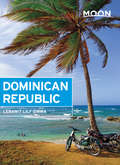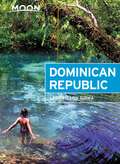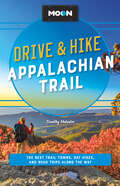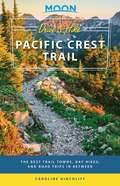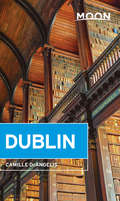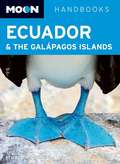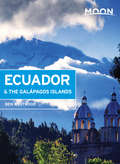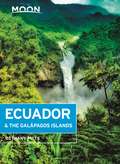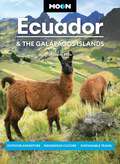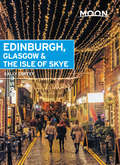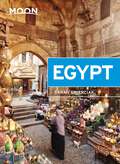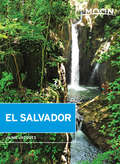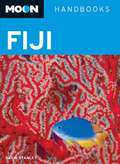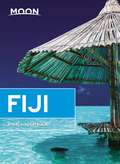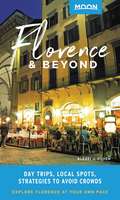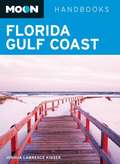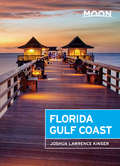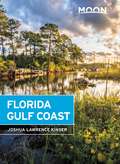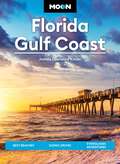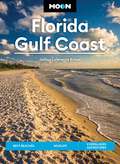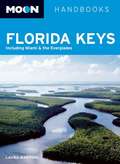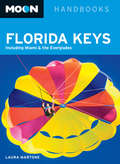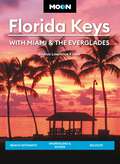- Table View
- List View
Moon Dominican Republic
by Lebawit Lily GirmaMake Your Escape with Moon Travel Guides!Diamond white beaches, cool forests, countrywide carnivals, and never ending music: discover for yourself why so many have fallen head over heels for the Dominican Republic. Get the down-low on the DR with Moon Dominican Republic. What You'll Find in Moon Dominican Republic:Local insight from frequent resident Lebawit Lily GirmaCurated trip advice for culture buffs, honeymooners, foodies, night owls, or outdoor adventurers, whether you're in the Caribbean for a few days or a few weeksFull-color, vibrant photos throughoutDetailed maps for exploring on your own, and useful tips on public transportation, car and bike rentals, and air travelStrategic itineraries for every budget, passion, and timeline, including: The Best of the Dominican Republic in 10 Days, Romancing the DR, Best Beaches, Diving and Snorkeling, Roots and Rhythms, Social Impact Tourism, and Adventure AwaitsFun ideas catered to every kind of traveler: Take a dip in the crystal-clear water, and dry off with a walk to one of the best seaside fish shacks for lunch. Enjoy a rich Dominican mangú and coffee for breakfast before a day of snorkeling alongside spotted eagle rays. Wander the clamor of the outdoor markets, and stroll amid restored Spanish colonial buildings and boutique sidewalk restaurants. Hike to hidden waterfalls or go zip lining through the forest, and dance the night away to local live merengueFocused coverage of Santo Domingo, Punta Cana and the Southeast Coast, the Samaná Peninsula, Puerto Plata and the North Coast, Santiago and the Cibao Valley, and Barahona and the SouthwestThorough background information on the landscape, plants and animals, history, government, and cultureHandy tools including a Spanish phrasebook, health and safety tips, and visa informationWith Moon Dominican Republic's myriad activities, practical advice, and insider tips, you can plan your trip your way.Craving more Caribbean adventures? Try Moon Jamaica or Moon Aruba.
Moon Dominican Republic (Travel Guide)
by Lebawit Lily GirmaDiamond white beaches, countrywide carnivals, and irresistible music: discover why so many have fallen head-over-heels for the DR. Inside Moon Dominican Republic you'll find:Flexible itineraries including the best of the Dominican Republic in 10 days, plus roundups of the best beaches, spots for diving and snorkeling, outdoor adventures, and moreStrategic advice for honeymooners, foodies, night owls, and more, whether you're in the DR for a few days or a few weeksThe top activities and unique experiences: Don a mask and join in the frenzy of Carnival or dance the night away to live merengue. Visit a cacao plantation or organic coffee farm, snack on fried plantains or a breakfast of mangú, and explore the bustling markets. Stroll along cobblestone streets and admire 16th-century churches, palaces, courthouses, and statues or take a community tour for a deeper understanding of local lifeOutdoor adventures: Enjoy miles of sand and clear water for sunbathing, swimming, and playing in the waves. Hike to hidden waterfalls or zipline through the forest. Dive to shipwrecks, snorkel alongside spotted eagle rays, or try kitesurfingWays to respectfully engage with culture from DR-insider Lebawit Lily Girma, from supporting small businesses to exploring ethically and sustainablyFull-color photos and detailed maps throughoutThorough background on the landscape, wildlife, history, government, and cultureHandy tools including a Spanish phrasebook, health and safety tips, visa information, and advice for LGBTQ, senior, and solo travelersWith Moon Dominican Republic's practical advice and local insight, you can find your adventure.Craving more of the Caribbean? Try Moon Bahamas or Moon Aruba.
Moon Drive & Hike Appalachian Trail: The Best Trail Towns, Day Hikes, and Road Trips Along the Way (Travel Guide)
by Timothy MalcolmWhether you're stopping for a day trek or taking a weekend getaway, hit the road and hike the legendary trail with Moon Drive & Hike Appalachian Trail.Make your escape on shorter trips from major cities or drive the entire three-week route from Georgia to Maine Find your hike along the Appalachian Trail with detailed trail descriptions, mileage, difficulty ratings, and tips for picking the right section of the trail for you Discover adventures off the trail: Immerse yourself in the spirit of colorful trail towns, peep the changing leaves in the Berkshires, and cruise the sun-dappled Skyline Drive. Kick back after a day hike at a microbrewery in Asheville, dig in to southern barbecue (hey, you've earned it), or unwind in the coffee shops and art galleries of a hip New England hamlet Take it from avid hiker Timothy Malcolm, who shares his insight on the best views, waterfalls, mountains, and (of course!) breweries Full-color photos, strategic itineraries, easy-to-use maps and site-to-site driving times Get the lowdown on when and where to get gas, how to avoid traffic, and braving different road and weather conditions, plus tips for LGBTQ travelers, seniors, and road-trippers with kids With Moon Drive & Hike Appalachian Trail's practical tips and local know-how, you're ready to lace up your hiking boots, pick a trailhead, and embark on your adventure. Doing more than driving through? Check out Great Smoky Mountains National Park or Moon Best of Acadia. About Moon Travel Guides: Moon was founded in 1973 to empower independent, active, and conscious travel. We prioritize local businesses, outdoor recreation, and traveling strategically and sustainably. Moon Travel Guides are written by local, expert authors with great stories to tell—and they can't wait to share their favorite places with you. For more inspiration, follow @moonguides on social media.
Moon Drive & Hike Pacific Crest Trail: The Best Trail Towns, Day Hikes, and Road Trips In Between (Travel Guide)
by Moon Travel Guides Caroline HinchliffWhether you're stopping for a day trek or taking a weekend getaway, hit the road and hit the legendary trail with Moon Drive & Hike Pacific Crest Trail.Make your escape on shorter trips from nearby cities, hit all the national parks along the PCT, or drive the entire two-week route from California to WashingtonFind your hike along the Pacific Crest Trail with detailed trail descriptions, difficulty ratings, mileage, and tips for picking the right section of the trail for youDiscover adventures on and off the trail: Watch the bubbling mud pots below Lassen Peak or admire Joshua trees in the sparse and peaceful Mojave Desert. Savor artisan, homemade-style pies of all kinds in Julian, sample craft beers in Bend, or gorge yourself at Timberline Lodge's gourmet brunch buffet. Cross the Columbia River on the historic Bridge of the Gods, climb into the massive granite peaks of the North Cascades, or catch a magical sunrise over the eastern edge of Oregon's Crater LakeTake it from avid hiker Caroline Hinchliff, who shares her insight on the best spots for wildlife-watching, glamping, or having a Wild moment Full-color photos, strategic itineraries, easy-to-use maps and site-to-site driving timesGet the lowdown on when and where to get gas, how to avoid traffic, and braving different road and weather conditions, plus tips for LGBTQ travelers, seniors, and road-trippers with kidsWith Moon Drive & Hike Pacific Crest Trail's practical tips and local know-how, you're ready to lace up your hiking boots, pick a trailhead, and embark on your adventure.For more epic getaways, check out Moon Drive & Hike Appalachian Trail.
Moon Dublin (Travel Guide)
by Camille DeangelisYour World Your WayTravel writer and Irish transplant Camille DeAngelis shares her expert perspective on the Emerald Isle, guiding you on a memorable and unique experience.Whether you're looking forward to nursing a pint of Guinness in a real Irish pub or hoping to explore the lush and misty landscape of this Celtic island, Moon Dublin has activities for every traveler. With itineraries like "Of Castles and Kings" and "Ghosts of Ancient Ireland," expertly crafted maps, gorgeous photos, and Camille's trustworthy advice, Moon Dublin provides the tools for planning your perfect trip!
Moon Ecuador & the Galápagos Islands
by Ben WestwoodSeasoned traveler and journalist Ben Westwood leads adventurers to off-the-beaten-path experiences in Ecuador, from riding a train up the steep switchbacks of the famous Nariz del Diablo (Devil’s Nose) to diving off of the Galápagos Islands, where the waters are abundant with ocean life. Westwood also includes several trip strategies—such as the Culture and History Tour and the Outdoor Adventure Tour—which cater to the diverse interests of travelers. Complete with information on exploring the colonial architecture of Quito's Old Town and climbing volcanoes in Sangay National Park, Moon Ecuador & the Galápagos Islands gives travelers the tools they need to create a more personal and memorable experience.
Moon Ecuador & the Galápagos Islands
by Ben WestwoodThis full-color guide to Ecuador and the Galápagos Islands includes vibrant photos and helpful planning maps.Seasoned traveler and journalist Ben Westwood leads adventurers to off-the-beaten-path experiences in Ecuador, from riding a train up the steep switchbacks of the famous Nariz del Diablo (Devil's Nose) to diving off of the Galápagos Islands, where the waters are abundant with ocean life. Westwood also includes several trip strategies-such as the Culture and History Tour and the Outdoor Adventure Tour-which cater to the diverse interests of travelers. Complete with information on exploring the colonial architecture of Quito's Old Town and climbing volcanoes in Sangay National Park, Moon Ecuador & the Galápagos Islands gives travelers the tools they need to create a more personal and memorable experience.
Moon Ecuador & the Galápagos Islands (Travel Guide)
by Bethany PittsCanoe through the Amazon, explore the bustling capital of Quito, snorkel in the Galápagos, or kick back on the coast: Embark on an unforgettable adventure with Moon Ecuador & the Galápagos Islands. Inside you'll find:Flexible itineraries for spending time in the Sierras, the Amazon, the coast, Quito, and the Galápagos IslandsStrategic advice for ethical travelers, adventure lovers, budget travelers, history and culture buffs, wellness seekers, and moreMust-see highlights and unique experiences: Hike through the Amazon rainforest, paddle across lily-covered lagoons, and spot camian, tapir, or pink river dolphins. Dive with hammerhead sharks in the Galápagos, cycle the epic waterfall route in Baños, and watch the sun rise over the peaks where the Amazon meets the Andes. Wander cobbled colonial streets and gaze up at snow-capped volcanoes rising from wildflower-strewn grasslands. Take a surfing lesson in Montañita, and relax on the beach with a mojito in hand How to ethically experience Ecuador like an insider, support local and sustainable businesses, and respectfully engage with the indigenous communities, including those with shamanic traditions Expert insight from local author Bethany Pitts on where to eat, how to get around, where to stay, and how to avoid crowds Full-color photos and detailed maps throughout Reliable background on the landscape, climate, wildlife, and history, as well as health and safety advice, environmental issues, and common customs and etiquette Handy tools including a Spanish phrasebook, volunteer opportunities, packing suggestions, and travel tips for families with kids, seniors, travelers with disabilities, and LGBTQ travelersWith Moon Ecuador & the Galápagos Islands' practical tips and local know-how, you can plan your trip your way.Exploring more of South America? Check out Moon Chile or Moon Colombia.
Moon Ecuador & the Galápagos Islands: Outdoor Adventure, Indigenous Culture, Sustainable Travel (Moon Latin America & Caribbean Travel Guide)
by Bethany Pitts Moon Travel GuidesCanoe through the Amazon, explore the bustling capital of Quito, snorkel in the Galápagos, or kick back on the coast: Embark on an unforgettable adventure with Moon Ecuador & the Galápagos Islands. Inside you'll find:Flexible itineraries for spending time in the Sierras, the Amazon, the coast, Quito, and the Galápagos Islands Must-see highlights and unique experiences: Hike through the Amazon rainforest, paddle across lily-covered lagoons, and spot camian, tapir, or pink river dolphins. Dive with hammerhead sharks in the Galápagos, cycle the epic waterfall route in Baños, and watch the sun rise over the peaks where the Amazon meets the Andes. Wander cobbled colonial streets and gaze up at snow-capped volcanoes rising from wildflower-strewn grasslands. Take a surfing lesson in Montañita, and relax on the beach with a mojito in hand How to ethically experience Ecuador like an insider, support local and sustainable businesses, and respectfully engage with the indigenous communities, including those with shamanic traditions Expert insight from local author Bethany Pitts on what to eat, how to get around, where to stay, and how to avoid crowds Full-color photos and detailed maps throughout Reliable background on the landscape, climate, wildlife, and history, as well as health and safety advice and common customs and etiquette Handy tools including a Spanish phrasebook, volunteer opportunities, packing suggestions, and travel tips for families with kids, seniors, travelers with disabilities, and LGBTQ travelers With Moon Ecuador & the Galápagos Islands' practical tips and local know-how, you can plan your trip your way. Heading to Central America? Check out Moon Costa Rica. Sticking to the islands? Try Moon Galápagos Islands.About Moon Travel Guides: Moon was founded in 1973 to empower independent, active, and conscious travel. We prioritize local businesses, outdoor recreation, and traveling strategically and sustainably. Moon Travel Guides are written by local, expert authors with great stories to tell—and they can't wait to share their favorite places with you. For more inspiration, follow @moonguides on social media.
Moon Edinburgh, Glasgow & the Isle of Skye (Travel Guide)
by Sally CoffeyFrom sipping scotch and sampling haggis to touring castles and historic museums, make the most of your Scottish adventure with Moon Edinburgh, Glasgow & the Isle of Skye. Inside you'll find:Flexible itineraries such as one to three days in Edinburgh and Glasgow, two days in the Highlands, and four days on the Isle of Skye that can be expanded or combined into a longer trip, including day trips to Loch Lomond, Ben Nevis, and moreStrategic advice for art lovers, history buffs, road trippers, and moreExplore the Cities: Walk along Edinburgh's historic Royal Mile from the Edinburgh Castle to the Queen's Scottish Palace or climb the Arthur's Seat peak. Sample authentic haggis and dine at innovative new restaurants. Catch a traditional music performance in Glasgow (the UNESCO City of Music!) or chat with locals at a corner pub over folk music and a pintEscape the Crowds: Hike through wild moors and pine forests to deserted villages on Skye, sip your way through Islay's whisky distilleries, or take a seaplane over Loch Lomond for dramatic views of the HighlandsValuable perspective from Scotland expert Sally CoffeyFull-color photos and detailed maps throughoutBackground information on the landscape, history, and cultural customs of ScotlandHandy tools such as visa information, a glossary and list of Scottish phrases, and helpful tips for seniors, disability access, families with children, LGBTQ visitors, and travelers of colorWith Moon Edinburgh, Glasgow & the Isle of Skye's practical tips and local insight, you can plan your trip your way.Exploring beyond Scotland? Check out Moon London Walks or Moon Ireland.
Moon Egypt (Travel Guide)
by Sarah SmierciakFrom the breathtaking traces of the ancient world to the colorful corals of the Red Sea, experience a land of treasures with Moon Egypt. Inside you'll find:Strategic, flexible itineraries including a two-week Best of Egypt The top historic sights: Wander in the shadows of kings at Luxor&’s Karnak Temple and stroll the Avenue of Sphinxes. Marvel at the magnificent temple of Queen Hatshepsut, travel back in time at the Grand Egyptian Museum, or wind your way through colorful backstreet markets in search of the perfect handmade souvenir Outdoor adventures: Summit historic Mt. Sinai at dawn or spend an evening horseback riding near the Great Pyramid of Giza. Escape the chaos of Cairo on a felucca boat cruise or bike through the City of the Dead. Kayak the Nile and camp under the stars in the White Desert The best local flavors: Feast on traditional Egyptian street food, dig into fresh seafood in Alexandria, and indulge your sweet tooth with a plate of kunafa or basbousaFirsthand insight from Cairo resident and American expat Sarah Smierciak on how to experience the real Egypt and avoid crowds Full-color, vibrant photos throughoutDetailed maps and useful tips for navigating public transportation and taxis Focused coverage of Cairo and Giza, the Northern and Southern Nile Valleys (including Luxor and Nubia), Alexandria, the Suez Canal, the Red Sea Coast, South Sinai, and the Western Desert Helpful resources on Covid-19 and traveling to Egypt Thorough background information on the landscape, wildlife, history, government, culture, and local customs Handy tools including an Egyptian Arabic phrasebook and tips for travelers who are LGBTQ+, disabled, women traveling solo, as well as families with children With Moon's practical advice and insider tips, you can experience the best of Egypt. Exploring nearby? Try Moon Israel & the West Bank. Want to see more of Northern Africa? Check out Moon Morocco. About Moon Travel Guides: Moon was founded in 1973 to empower independent, active, and conscious travel. We prioritize local businesses, outdoor recreation, and traveling strategically and sustainably. Moon Travel Guides are written by local, expert authors with great stories to tell—and they can't wait to share their favorite places with you. For more inspiration, follow @moonguides on social media.
Moon Egypt: Temples & Pyramids, Nile Sailing & Cruises, Desert Safaris (Moon Middle East & Africa Travel Guide)
by Moon Travel Guides Sarah SmierciakFrom the breathtaking sites of the ancient world to the colorful corals of the Red Sea, experience a land of treasures with Moon Egypt. Inside you'll find:Strategic, flexible itineraries including a one-week best of Egypt trip, a week of snorkeling, and moreCan't-miss experiences: Wander in the shadows of kings at Luxor&’s Karnak Temple and stroll the Avenue of Sphinxes. Marvel at the magnificent temple of Queen Hatshepsut, travel back in time at the Grand Egyptian Museum, or wind your way through colorful backstreet markets in search of the perfect handmade souvenir Outdoor adventures: Summit historic Mt. Sinai at dawn or spend an evening horseback riding near the Great Pyramid of Giza. Escape the chaos of Cairo on a felucca boat cruise or bike through the City of the Dead. Kayak the Nile and camp under the stars in the White Desert The best local flavors: Feast on traditional Egyptian street food, dig into fresh seafood in Alexandria, and indulge your sweet tooth with a plate of kunafa or basbousa Firsthand insight from Cairo resident and American expat Sarah Smierciak on how to experience the real Egypt and avoid crowds Full-color, vibrant photos throughoutDetailed maps and useful tips for navigating public transportation and taxis Thorough background information on the landscape, wildlife, history, government, culture, and local customs Handy tools including an Egyptian Arabic phrasebook and tips for accessibility, LGBTQ+ travelers, women traveling solo, and families with children Focused coverage of Cairo and Giza, the Northern and Southern Nile Valleys (including Luxor and Nubia), Alexandria, the Suez Canal, the Red Sea Coast, South Sinai, and the Western Desert With Moon's practical advice and insider tips, you can experience the best of Egypt. Want to see more of Northern Africa? Check out Moon Morocco.About Moon Travel Guides: Moon was founded in 1973 to empower independent, active, and conscious travel. We prioritize local businesses, outdoor recreation, and traveling strategically and sustainably. Moon Travel Guides are written by local, expert authors with great stories to tell—and they can&’t wait to share their favorite places with you. For more inspiration, follow @moonguides on social media.
Moon El Salvador (Moon Handbooks)
by Jaime JacquesMoon Handbooks give you the tools to make your own choices.Can't-miss sights, activities, restaurants, and accommodations, marked with MEssential info on San Salvador, El Salvador's resilient urban heartSuggestions on how to plan a trip that's perfect for you, including:The Best of El SalvadorSurf's Up!From Cool Cloud Forests to Warm WavesArt and Culture: Past and Present13 detailed and easy-to-use mapsThe firsthand experience and unique perspective of author Jaime JacquesThis ebook and its features are best experienced on iOS or Android devices and the Kindle Fire.
Moon Fiji
by David StanleySouth Pacific expert and veteran travel writer David Stanley knows the best way to experience Fiji, from making the most of one of the world's premiere diving spots to getting away from it all in lesser-known villages. David provides great trip ideas for a variety of travelers, such as Best of Fiji, Island-Hopper Special, and The Life Aquatic. Packed with information on swimming the reefs, taking day-long boat cruises, and sampling Fijian specialties, Moon Fiji gives travelers the tools they need to create a more personal and memorable experience.
Moon Fiji (Travel Guide)
by Minal HajratwalaExplore the colorful reefs, volcanic canyons, emerald rainforests, and unspoiled beaches of this sparkling archipelago with Moon Fiji. Inside you'll find:Flexible itineraries including four days on Taveuni Island, five days of island-hopping in the Yasawas, and the ten-day best of FijiStrategic advice for outdoor adventurers, diving enthusiasts, honeymooners, foodies, and more, with guidance on which island is right for youMust-see highlights and unique experiences: Go scuba-diving and spot barracuda, manta rays, and dolphins. Hike the rain-filled crater of a dormant volcano, raft down the thrilling Navua River, or zip-line through old-growth yesi forests. Share an intoxicating bowl of kava with new friends, tour an inland sugar plantation, or immerse yourself in the vibrant culture of indigenous peoples at a VOU dance performance. Sample fresh papaya, passionfruit, and mangoes from local growers or go off the grid in a traditional Fijian village, where you can practice mountainside yoga and learn to river fish with localsExpert insight: Minal Hajratwala, a writer with lifelong family ties to Fiji, recommends where to eat, how to get around, and where to stay, from guest cottages and beach bungalows to luxurious resortsFull-color photos and detailed maps throughoutReliable background information on the landscape, climate, wildlife, and history, as well as common customs, etiquette, and basic Fijian and Hindi phrasebooksHandy tips for families, seniors, students, and travelers with disabilities, plus ideas for traveling sustainably and engaging with the cultureWith Moon Fiji's practical tips and local know-how, you can experience the best of Fiji.Exploring the South Pacific? Check out Moon New Zealand.
Moon Florence & Beyond: Day Trips, Local Spots, Strategies to Avoid Crowds (Travel Guide)
by Alexei J. CohenWorld-famous galleries, medieval towers, bustling sidewalk cafés, and a culture steeped in artistic innovation: savor the best of Firenze at your own speed with Moon Florence & Beyond.Explore In and Around the City: Get to know Florence's most interesting neighborhoods like the historic center, Santa Croce, San Marco, and Santa Maria Novella, and nearby areas including Lucca, San Gimignano, Siena, Chianti, and moreGo at Your Own Pace: Choose from multiple itinerary options designed for foodies, history buffs, art lovers, and moreSee the Sights: Climb to the top of the gravity-defying Duomo, gaze at Michelango's David at the Accademia, see world-famous works at the Uffizi Gallery, or hike to the Basilica San Miniato al Monte for undisturbed views of the city skylineGet Outside the City: Escape the crowds and explore rolling Tuscan hill towns, the charming medieval city of Lucca, and the vineyards of ChiantiSavor the Flavors: Linger over an aperitivo at sunset, sample mouthwatering gelato, explore the city's burgeoning modern restaurant scene, or enjoy a traditional Florentine meal at an old-school trattoriaExperience the Nightlife: From a classic Negroni at an al fresco café to a swanky champagne bar or a neighborhood enoteca serving local Brunellos, find the best of Florence's many watering holesGet to Know the Real Florence: Follow local suggestions from Italian transplant Alexei CohenFull-Color Photos and Detailed MapsHandy Tools: Background information on Florentine history and culture, plus tips on sustainable travel, what to pack, where to stay, and how to get aroundDay trip itineraries, favorite local spots, and strategies to skip the crowds: Take your time with Moon Florence & Beyond.Exploring more of Italy? Check out Moon Venice & Beyond or Moon Milan & Beyond: With the Italian Lakes.
Moon Florida
by Jason FergusonNative Floridian and travel writer Jason Ferguson covers the best of the Sunshine State, from perusing Pensacola and the Panhandle to mingling with Mickey in Walt Disney World and going the distance in Daytona Beach. Ferguson includes unique trip ideas for a variety of travelers, such as "The Old Florida Tour" and "The Rockets and Racecars Tour". With expert advice on exploring the tropical climate of Miami, the Florida Keys, the lush Everglades, and the Tampa Bay area, Moon Florida gives travelers the tools they need to create a more personal and memorable experience.
Moon Florida Gulf Coast
by Joshua Lawrence KinserLong-time Florida resident Joshua Kinser covers the best of the Gulf Coast, from the mangroves of Everglades National Park to the glass skyscrapers and lazy canals of Tampa. Kinser has plenty of fun, interesting trip strategies to offer, including Best Beaches, Camping on the Coast, and RV the GC. Complete with details on snorkeling and diving the Nature Coast's Caverns, wandering through the historical sites of Apalachicola and Tallahassee, and fishing along miles of coast and parkland, Moon Florida Gulf Coast gives travelers the tools they need to create a more personal and memorable experience.
Moon Florida Gulf Coast (Moon Handbooks Ser.)
by Joshua Lawrence KinserLong-time Florida resident Joshua Lawrence Kinser covers the best of the Gulf Coast, from the mangroves of Everglades National Park to the glass skyscrapers and lazy canals of Tampa. Kinser has plenty of fun, interesting trip strategies to offer, including Best Beaches, Camping on the Coast, and RV the GC. Complete with details on snorkeling and diving the Nature Coast's Caverns, wandering through the historical sites of Apalachicola and Tallahassee, and fishing along miles of coast and parkland, Moon Florida Gulf Coast gives travelers the tools they need to create a more personal and memorable experience.
Moon Florida Gulf Coast (Travel Guide)
by Joshua Lawrence KinserWhether you're kayaking through mangroves, bodysurfing with manta rays, or sunbathing with a piña colada in hand, soak up the Sunshine State with Moon Florida Gulf Coast. Inside you'll find: Flexible itineraries from short beach getaways to a 10-day road trip covering all 700 miles of the Florida Gulf CoastStrategic advice for beach-goers, wildlife enthusiasts, water sports lovers, and moreThe best spots for outdoor adventures like kayaking, hiking, biking, bird-watching, and fishing, and the best beaches for swimming, sunsets, and seclusionTop activities and unique experiences: Discover the vibrant performing arts scene in Sarasota or stroll through quaint riverfront towns and secluded island enclaves. Unwind on shell-scattered beaches, explore winding mazes of mangroves, or spot gators in the swampy Everglades. Ride the coasters at Busch Gardens, browse art galleries in Naples, or check out a local swamp buggy race. Sail through the canals of Tampa, kick back at a beachfront oyster bar, and sip a local brew as the sun sets over the oceanExpert advice from Florida native Jason Ferguson on where to stay, where to eat, and how to get around by car, bus, or boatFull-color photos and detailed maps throughoutBackground information on the Gulf Coast's landscape, wildlife, history, and cultureHandy tips for international visitors, families with kids, LGBTQ travelers, and travelers with disabilitiesWith Moon Florida Gulf Coast's practical advice and local know-how, you can plan your trip your way.For more of the Sunshine State, try Moon Florida Keys. Hitting the road? Check out Moon South Florida & the Keys Road Trip.
Moon Florida Gulf Coast: Best Beaches, Scenic Drives, Everglades Adventures (Travel Guide)
by Joshua Lawrence KinserWhether you're kayaking through mangroves, bodysurfing with manta rays, or sunbathing with a piña colada in hand, soak up the Sunshine State with Moon Florida Gulf Coast. Inside you'll find: Flexible itineraries from short beach getaways to a 10-day road trip covering all 700 miles of the Florida Gulf Coast The best spots for outdoor adventures like kayaking, hiking, biking, bird-watching, and fishing, and the best beaches for swimming, sunsets, and seclusion Top activities and unique experiences: Discover the vibrant performing arts scene in Sarasota or stroll through quaint riverfront towns and secluded island enclaves. Unwind on shell-scattered beaches, explore winding mazes of mangroves, or spot gators in the swampy Everglades. Ride the coasters at Busch Gardens, browse art galleries in Naples, or catch a college baseball game during Spring Training. Sail through the canals of Tampa, kick back at a beachfront oyster bar, and sip a local brew as the sun sets over the ocean Expert advice from Florida native Joshua Lawrence Kinser on where to stay, where to eat, and how to get around by car, bus, or boat Full-color photos and detailed maps throughoutBackground information on the Gulf Coast's landscape, wildlife, history, and culture Experience the best of Florida's Gulf Coast with Moon. For more of the Sunshine State, try Moon Florida Keys. About Moon Travel Guides: Moon was founded in 1973 to empower independent, active, and conscious travel. We prioritize local businesses, outdoor recreation, and traveling strategically and sustainably. Moon Travel Guides are written by local, expert authors with great stories to tell—and they can't wait to share their favorite places with you. For more inspiration, follow @moonguides on social media.
Moon Florida Gulf Coast: Best Beaches, Wildlife, Everglades Adventures (Moon U.S. Travel Guide)
by Joshua Lawrence Kinser Moon Travel GuidesWhether you're kayaking through mangroves, bodysurfing with manta rays, or sunbathing with a piña colada in hand, soak up the Sunshine State with Moon Florida Gulf Coast. Inside you'll find: Flexible itineraries including a 5-day family vacation, a baseball spring training trip, and a 10-day road trip covering all 700 miles of the Florida Gulf Coast The best spots for outdoor adventures like kayaking, hiking, biking, bird-watching, and fishing, and the best beaches for swimming, sunsets, and seclusion Top activities and unique experiences: Discover the vibrant performing arts scene in Sarasota or stroll through quaint riverfront towns and secluded island enclaves. Unwind on shell-scattered beaches or spot gators in the swampy Everglades. Ride the coasters at Busch Gardens, browse art galleries in Naples, or catch a college baseball game during Spring Training. Sail through the canals of Tampa, kick back at a beachfront oyster bar, and sip a local brew as the sun sets over the ocean Expert advice from Florida local Joshua Lawrence Kinser on where to stay, what to eat, and how to get around by car, bus, or boat Full-color photos and detailed maps throughoutBackground information on the Gulf Coast's landscape, wildlife, history, and culture Experience the best of Florida's Gulf Coast with Moon. For more of the Sunshine State, try Moon Florida Keys.About Moon Travel Guides: Moon was founded in 1973 to empower independent, active, and conscious travel. We prioritize local businesses, outdoor recreation, and traveling strategically and sustainably. Moon Travel Guides are written by local, expert authors with great stories to tell—and they can't wait to share their favorite places with you. For more inspiration, follow @moonguides on social media.
Moon Florida Keys
by Laura MartoneWorld traveler Laura Martone shares the best ways to experience the Florida Keys, from diving the fascinating underwater coral reefs and shipwrecks of Key Largo to hiking and camping in the less touristy Middle Keys. Martone offers unique trip ideas for a variety of travelers, including A Weekend in Key West, Sun and Sand Galore, and Art and Architecture. Complete with information on taking trolley tours, swimming with dolphins, and attending festivals like the Lighted Boat Parade, Moon Florida Keys gives travelers the tools they need to create a more personal and memorable experience.
Moon Florida Keys
by Laura MartoneWorld traveler Laura Martone shares the best ways to experience the Florida Keys, from diving the fascinating underwater coral reefs and shipwrecks of Key Largo to hiking and camping in the less touristy Middle Keys. Martone offers unique trip ideas for a variety of travelers, including Historic Architecture, Underwater Journey, and Romantic Key West Getaway. Complete with information on taking trolley tours, swimming with dolphins, and attending festivals like the Key Largo Pirates Fest, Moon Florida Keys gives travelers the tools they need to create a more personal and memorable experience.Coverage includes:Miami and the EvergladesKey LargoIslamoradaMarathon and the Middle KeysBig Pine and the Lower KeysKey West
Moon Florida Keys: Beach Getaways, Snorkeling & Diving, Wildlife (Travel Guide)
by Joshua Lawrence KinserFrom Miami to Loggerhead Key in the Dry Tortugas, get to know this free-spirited archipelago of beaches, palm trees, and fun with Moon Florida Keys. Inside you'll find:Strategic itineraries for water sports lovers, wildlife fanatics, families with kids, foodies, and more, including a Key West getaway and a week-long road trip along the Overseas Highway Unique experiences and can't-miss sights: Explore the fascinating coral reefs and shipwrecks of Key Largo or visit Hemingway's house to meet the descendants of his legendary polydactyl cats. Spot colorful birds or canoe with gators in the Everglades. Venture through mangrove and pine forests inhabited by endangered species in the National Key Deer Refuge. Catch the sunrise on a secluded beach or dance the night away at Florida's best clubs and bars Local flavors: Taste authentic Cuban chicken stew, fried plantains drizzled with honey, and flaky pastelitos in Miami. Sip refreshing mojitos and try award-winning key lime pie in Key West. Savor some of the best fresh seafood in the country or satisfy your adventurous side with fried alligator tail and conch fritters The best outdoor sports and recreation, including sailing, fishing, kayaking, biking, diving, and snorkeling along the only living barrier reef in the continental USA Expert insight and honest advice from Florida local Joshua Lawrence Kinser on when to go, how to get around, and where to stay, from historic inns and beachside B&Bs to budget motels and campgrounds Full-color photos and detailed maps throughoutThorough background on the landscape, climate, wildlife, and local culture With Moon's expert advice and local know-how, you can experience the best of the Florida Keys. Exploring beyond the Keys? Check out Moon Florida Gulf Coast.About Moon Travel Guides: Moon was founded in 1973 to empower independent, active, and conscious travel. We prioritize local businesses, outdoor recreation, and traveling strategically and sustainably. Moon Travel Guides are written by local, expert authors with great stories to tell—and they can't wait to share their favorite places with you. For more inspiration, follow @moonguides on social media.
